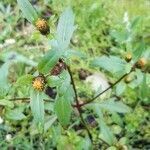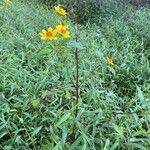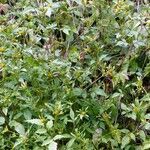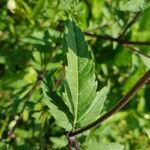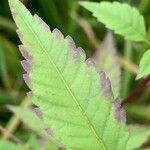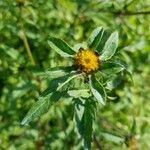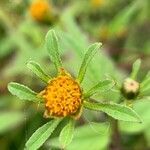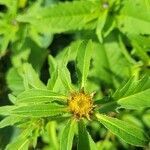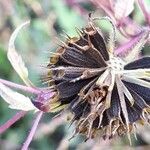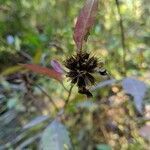Annuals, (5–)20–70(–200) cm. Leaves sessile or petioles 5–15(–35+) mm (± winged); blades ± elliptic to ovate or lanceolate, 40–80(–150+) × 15–40(–60+) mm, sometimes laciniately 1-pinnatisect with 1–4+ lobes near bases, bases cuneate, margins entire or dentate to serrate, usually ciliate, apices acute to acuminate, faces glabrous or hirtellous. Heads borne singly or in 2s or 3s. Peduncles 10–40(–80) mm. Calyculi of (2–)6–7(–10) ± spreading, oblanceolate or lanceolate to linear, ± foliaceous bractlets or bracts 7–35(–60) mm, margins (entire or serrate) sometimes sparsely ciliate, abaxial faces hispidulous near bases, distally glabrous. Involucres campanulate to hemispheric or broader, (4–)5–7(–12) × (3–)6–12(–15+) mm. Phyllaries (6–)7–8(–13), elliptic-ovate to lance-ovate, (4–)6–9(–12) mm. Ray florets usually 0, sometimes 1–5; laminae orange yellowish, 4–8 mm. Disc florets (5–)20–60(–150+); corollas pale yellow to orange, (2–)3–4 mm (gradually ampliate, anthers usually pale). Cypselae blackish to purplish or brown, ± flattened, sometimes weakly 3(–4)-angled, usually cuneate to linear, outer (3–)6–7(–10) mm, inner (4–)6–9(–11) mm, margins proximally antrorsely to patently, distally retrorsely, barbed, apices ± truncate to concave, faces ± 1-nerved, usually smooth, seldom notably tuberculate, glabrous or sparsely strigillose; pappi 0, or of (1–)3–3(–4+) ± erect to spreading, retrorsely barbed awns (0.2–)2–3(–6) mm. 2n = 48.
Erect, glabrous or almost glabrous annual, 10-80 cm tall. Stems angled, branched above to form infl. Lvs petiolate, usually simple and not lobed, sometimes deeply 1-pinnatisect with 3-5 segments, 3-10-(20) cm long; lamina or segments narrowly ovate-elliptic to lanceolate, coarsely and often unevenly serrate, acuminate. Upper cauline lvs becoming smaller, shortly petiolate or apetiolate, not lobed and less distinctly serrate. Capitula 4-10 mm diam. Outer involucral bracts 3-4, foliaceous, glabrous, linear, 6-12 mm long; inner bracts many, membranous, ovate-elliptic to ovate-triangular, 5-8 mm long, with dark lined centre and pale margins. Receptacular scales similar to inner bracts but narrower. Florets all ☿, tubular, yellow-orange. Achenes flattened, ovate-cuneate to obtriangular, with 1 slender to prominent rib on each face, dark brown, ciliate and otherwise glabrous to sparsely hairy, 5-8 mm long; awns 2-4, often unequal, 0.5-2.7 mm long.
Annual herb 20–100 cm high; stems erect, glabrous or sparsely hairy. Leaves petiolate, broadly lanceolate to broadly ovate in outline, 6–16 cm long, 2–13 cm wide, usually 3-or 5-lobed, or simple, toothed, glabrous apart from tiny antrorse hairs on margins and veins; terminal lobes ovate; lateral lobes ovate to lanceolate; simple leaves lanceolate to ovate, 6–8 cm long, 2–3 cm wide. Capitula hemispherical, 10–25 (–30) mm diam.; outer involucral bracts ±spathulate, (10–) 15–40 mm long, usually exceeding florets, sparsely hairy near base; inner bracts lanceolate, glabrous. Ray florets usually absent, if present 1–5, with ligule 4–8 mm long, orange-yellow. Achenes homomorphic, oblong-cuneate, 4–8 mm long, compressed, black to purplish or brown, retrorsely barbed on ribs. Pappus awns 2 (–4), erect, 1.5–4 mm long.
An annual herb. It grows 15-60 cm high and spreads 10-30 cm wide. The stems are purple and 4 angled. The leaves are sword shaped or divided and have teeth along the edge. They are 11 cm long. The flowers are yellow-brown and like buttons. They have leaf-like bracts around them.
